When calling for fuel delivery, expect to provide specific details about your location, tank capacity, and preferred delivery timeframe. A customer service representative will guide you through scheduling options, including same-day or emergency delivery services if needed. You'll need to guarantee clear access to your tank location and confirm any security protocols or access codes. The delivery process involves strict safety measures, with drivers following environmental protection protocols and utilizing proper equipment for secure fuel transfer. Payment options typically include cash, credit cards, or pre-arranged payment plans. Understanding these key aspects helps facilitate a smooth, efficient delivery experience for ideal outcomes.
Expert Highlights
- The dispatcher will ask for your location details and schedule a delivery time that works within the facility's operating hours.
- You'll need to provide information about tank accessibility, capacity, and any security codes or access requirements.
- The delivery driver will require clear access routes that accommodate large commercial vehicles and proper turning radius.
- Safety protocols must be followed, including maintaining distance from ignition sources and having proper containment equipment ready.
- You'll need to arrange payment through approved methods like cash, credit cards, or established payment plans.
Making the Initial Contact
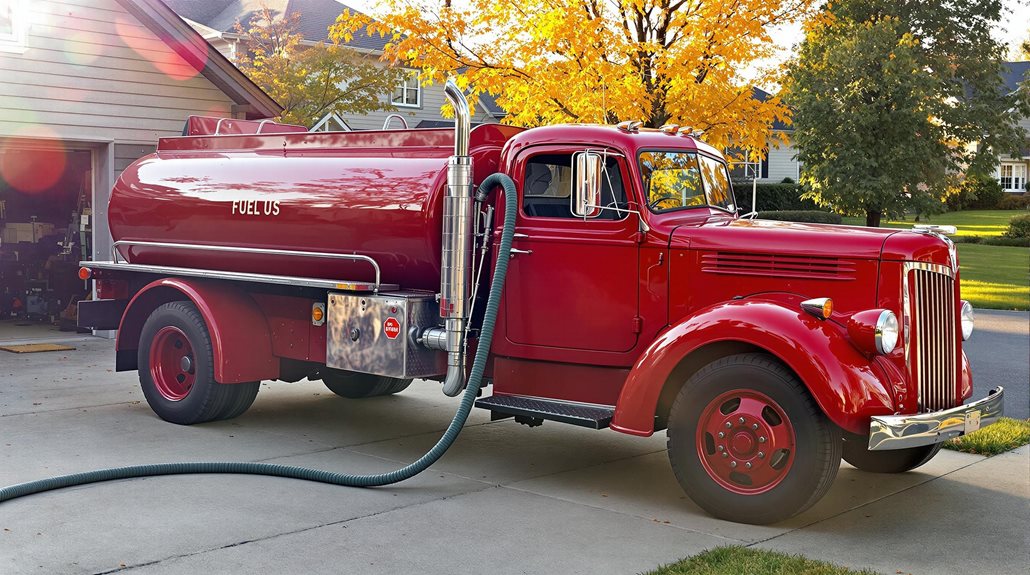
When arranging fuel delivery services, establishing clear communication during initial contact is crucial for guaranteeing a smooth and efficient delivery process. During your first call, be prepared to provide detailed information about your site's operating hours, preferred entrance points, and any specific access requirements or security protocols that delivery personnel must follow. It's essential to inform the delivery service about any access codes or locks that secure your fuel storage area. In Minnesota, many roadside assistance companies offer fuel delivery services as part of their emergency support.
You'll need to clearly communicate the exact location of your fuel storage tanks, including any identifying markers or tank designations. Additionally, inform the delivery service about documentation requirements and ensure you have designated an authorized representative who will be available on-site to sign necessary paperwork. Your delivery driver will provide a bill of lading upon completion of the fuel transfer. Providing comprehensive contact information for key personnel who can address potential delivery complications will facilitate seamless communication throughout the entire process.
Scheduling Your Delivery Time
Effective scheduling of fuel delivery times requires a thorough understanding of both operational needs and logistical capabilities. Our sophisticated scheduling system offers you multiple delivery options, including scheduled deliveries, emergency services, and specific time-slot arrangements to accommodate your unique requirements. Businesses can achieve increased operational efficiency by eliminating the need to manage fuel pickup schedules. Our fuel management technicians monitor delivery systems to ensure optimal performance and reliability.
Additionally, we provide emergency roadside assistance, including lockout services, to guarantee your access to help when needed. When you schedule your delivery, our team coordinates with suppliers and carriers while considering factors such as seasonal demand fluctuations and potential weather-related delays. We utilize advanced route optimization software to determine the most efficient delivery paths, ensuring timely service while maintaining cost-effectiveness. Our scheduling process includes built-in buffer times to account for unexpected circumstances, and we provide real-time updates regarding your delivery window. You'll have the flexibility to adjust your preferred delivery time based on your schedule, and we can accommodate last-minute changes without compromising service quality.
Site Access Requirements
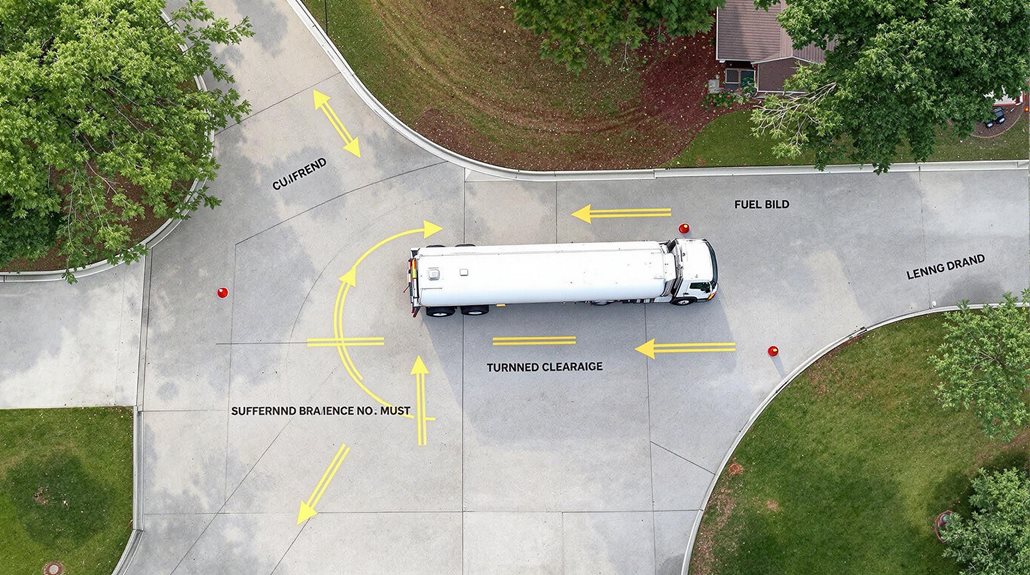
Proper site access for fuel delivery requires well-marked entry routes that allow efficient navigation of tanker trucks to their designated delivery points. The entrance and pathways must accommodate large commercial vehicles, with adequate turning radius, height clearance, and surface conditions suitable for heavy vehicles carrying hazardous materials. Same-day delivery service depends on having clear access to maintain efficiency and meet urgent customer needs. Ensuring these conditions can also facilitate prompt and efficient service, similar to the standards upheld in other roadside assistance services. Essential access equipment, including keys, security codes, and specialized tools for tank connections, must be readily available to guarantee a smooth and safe delivery process.
Clear Entry Routes Needed
Clear entry routes for fuel delivery vehicles represent a critical safety and operational requirement for any site receiving fuel shipments. To guarantee efficient and secure deliveries, organizations must establish and maintain unobstructed pathways that accommodate large tanker vehicles while adhering to safety protocols.
| Access Requirements | Implementation Measures |
|---|---|
| Entrance Designation | Clearly marked primary access point with proper signage |
| Time Management | Scheduled deliveries during designated operating hours |
| Security Protocols | Distribution of necessary access codes and keys to authorized personnel |
Professional fuel delivery services depend on well-documented site access information, including designated entrances, operating hours, and security measures. By maintaining clear entry routes and providing exhaustive access details, organizations can facilitate smooth deliveries while minimizing potential delays or safety concerns. This systematic approach ensures that both delivery personnel and site operators can execute their responsibilities effectively.
Access Equipment Requirements
Beyond establishing clear entry routes, successful fuel delivery operations require specific site access equipment and preparatory measures to guarantee safe and efficient operations. Essential requirements include properly installed safety barriers to control traffic flow and protect the fueling zone, along with clearly visible signage warning of flammable materials and prohibiting smoking in the vicinity.
The delivery area must be equipped with Class B fire extinguishers mounted in accessible locations, thorough spill response kits, and adequate lighting for visibility during operations. Fuel tanks must feature clean, functional spill buckets and appropriate overfill prevention devices. Additionally, accurate tank capacity charts must be readily available for delivery personnel, and all transfer equipment, including hoses and pumps, must meet current safety standards and undergo regular maintenance inspections.
Tank Location and Capacity
Proper tank location identification and capacity management are essential components of efficient fuel delivery operations, requiring careful documentation of access points and precise measurements for each storage vessel. Accurate assessment of tank sizes and available space guarantees safe delivery volumes while preventing overfilling risks, particularly when managing multiple storage units at a single location. Clear marking and documentation of tank positions, combined with thorough capacity calculations, enable delivery personnel to execute their tasks with maximum efficiency while maintaining stringent safety protocols. In the event of delivery truck issues, 24/7 availability for roadside assistance ensures minimal delays and continuity of service.
Clear Access Points
Maintaining readily accessible fuel tanks is crucial for efficient delivery operations. To guarantee seamless fuel deliveries, tanks must be positioned within 50 feet of designated access roads, which require a minimum width of 20 feet to accommodate delivery vehicles. These fire lanes must remain clear of any obstructions and avoid sharp turns that could impede truck movement.
For ideal service delivery, tanks should be strategically placed along the Esplanade, 2:00, and 10:00 roads, with additional access points available on the 9:00 side and select Keyholes. Critical safety protocols mandate that all areas surrounding the fill points remain free from ignition sources and open flames. Additionally, delivery vehicles must have the capability to proceed directly through to the street, necessitating well-planned, straight-line access routes to all fuel storage locations.
Tank Size Requirements
Strategically planning tank sizes and locations is essential for efficient fuel delivery operations. Standard fuel storage configurations at service stations typically range from 12,000 to 24,000 gallons per fuel grade, while specialized bulk diesel storage must maintain a minimum capacity of 133% of the emergency power supply system requirements.
The delivery infrastructure accommodates these substantial storage needs through various tanker truck configurations, most commonly utilizing 40 to 45-foot tanks with capacities between 9,000 and 12,000 gallons. These tanks must be positioned according to strict safety protocols, maintaining minimum distances of 20 feet from buildings and 10 feet from exterior walls.
For facilities requiring larger capacities, truck-and-trailer combinations extending up to 80 feet can be employed, ensuring ideal fuel delivery while adhering to all regulatory requirements.
Multiple Tank Management
Effective management of multiple fuel tanks requires a sophisticated approach to both location planning and capacity optimization. Modern fuel delivery systems can incorporate tanks ranging from 25 to 920 gallons, strategically positioned across various locations to guarantee continuous supply to equipment and vehicles.
These interconnected systems can accommodate up to six different service fluids, including diesel, oil, coolant, and DEF.
Advanced monitoring technologies enable real-time tracking of fluid levels across all tanks through centralized control systems, while integrated pumps and valves facilitate efficient transfer between containers. The implementation of secure auto ID refueling technologies and automated stock rotation systems ensures both safety and operational efficiency.
Tank configurations can be customized to match specific operational requirements, with mobile solutions like multi-tank trailers providing additional flexibility across multiple jobsites.
Safety Measures During Delivery
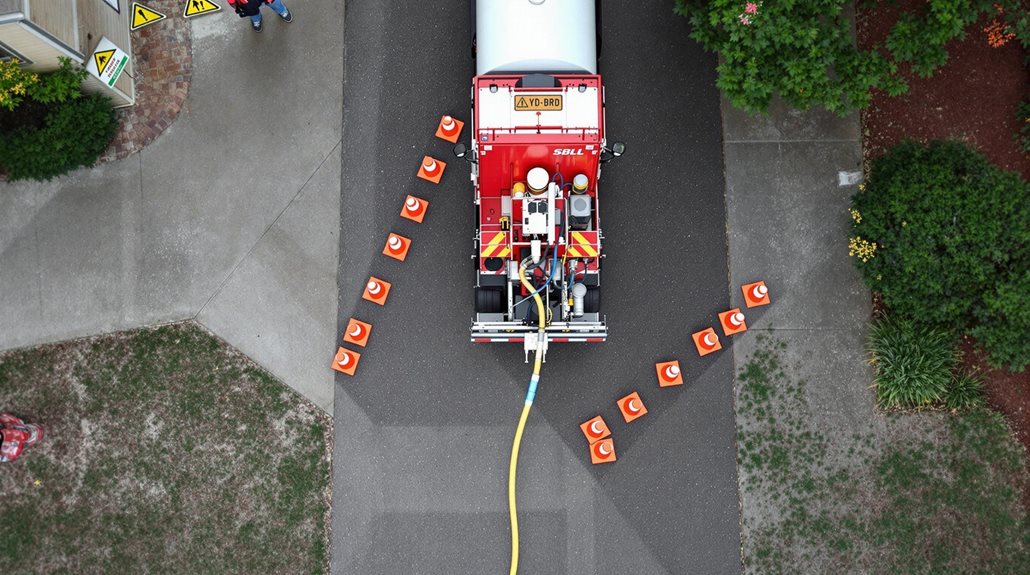
Safety protocols during fuel delivery operations are critical to prevent accidents and protect both personnel and property. Detailed safety measures include maintaining strict control over ignition sources, proper grounding procedures, and continuous monitoring of the delivery process. A professional tire change service is also recommended for drivers experiencing tire issues concurrently with fuel delivery, ensuring all aspects of roadside assistance adhere to safety standards.
| Key Safety Measure | Implementation Protocol |
|---|---|
| Ignition Control | No smoking, flames, or sparks permitted |
| Static Prevention | Connect grounding and bonding cables |
| Monitoring | Driver remains at truck flow valve |
| Emergency Response | Fire extinguisher readily accessible |
| Spill Management | Response kits available on-site |
The delivery process requires maintaining constant contact with the tank to minimize static electricity risks. Personnel must remain vigilant throughout the operation, ensuring proper connection of safety equipment and maintaining clear access to emergency shut-off mechanisms. These measures, combined with proper ventilation and rigorous site inspection, create a secure environment for fuel transfer operations.
The Fuel Transfer Process
The fuel transfer process begins with a thorough inspection of critical safety equipment, including spill kits, fire extinguishers, and personal protective equipment (PPE). Prior to initiating the transfer, storage tank preparation involves confirming tank capacity, checking fill connections, and ensuring proper grounding to prevent static discharge. Throughout the transfer operation, continuous monitoring of flow rates, pressure levels, and tank volumes is pivotal to prevent overfilling and maintain safe operating conditions. In Dinkytown MN, roadside assistance services such as fuel delivery are readily available to assist those in need.
Safety Equipment Check First
Fuel handlers must complete a thorough safety equipment check before initiating any transfer operations. The comprehensive inspection guarantees that all essential protective gear and emergency response equipment are readily available and in proper working condition. Professional fuel delivery teams meticulously verify the presence and functionality of each safety component.
| Required Equipment | Purpose |
|---|---|
| Fire-Resistant Attire | Protection from flames and heat |
| Safety Footwear | Prevention of slips and impacts |
| Protective Eyewear | Shield against fuel splashes |
| Emergency Response Kit | Immediate incident management |
This systematic verification process includes inspecting fire extinguishers, emergency showers, spill response materials, and personal protective equipment. The proper implementation of these safety measures safeguards both the delivery personnel and the facility, establishing a secure foundation for the subsequent fuel transfer operations.
Storage Tank Preparation Steps
Prior to initiating fuel transfer operations, thorough storage tank preparation involves a series of critical steps to certify safe and efficient delivery. The process begins with comprehensive pre-delivery checks, including accurate fuel level measurements and volume calculations to ascertain sufficient space for the incoming fuel.
Site accessibility requirements mandate clear entrance designation, precise tank location instructions, and updated access protocols. Environmental protection measures must be implemented through strategic placement of drain covers and collection equipment at key transfer points.
Additionally, proper logistical arrangements encompass scheduling deliveries during daylight hours, confirming authorized personnel are present for documentation, and maintaining clear communication channels. These systematic preparations establish a secure foundation for the fuel transfer process while protecting both personnel and the environment.
Monitoring During Fuel Transfer
Maintaining vigilant oversight during fuel transfer operations requires complete monitoring systems and protocols to guarantee safety, accuracy, and security. Advanced fuel management systems utilize real-time tank level measurements, electronic gauges, and automated data capture to track every aspect of the transfer process. Temperature-compensated measurements certify precise volume calculations, while integrated leak detection analysis safeguards against potential issues.
Throughout the delivery, sophisticated monitoring equipment continuously checks for anomalies, including bulk water detection and sudden pressure changes. High/low level alarms prevent overfill situations, while automated security features restrict unauthorized access.
The FuelHub™ software and FuelTrack controller work in tandem to provide thorough oversight, capturing manifest details and generating compliance reports. This systematic approach confirms that every fuel transfer adheres to regulatory requirements while maintaining ideal efficiency and safety standards.
Payment and Pricing Options
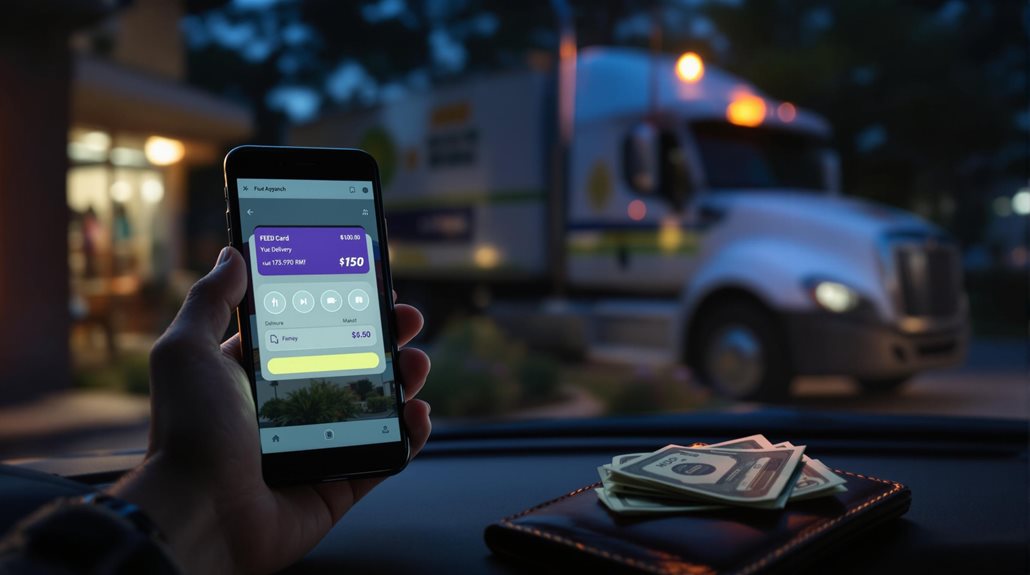
To guarantee customer convenience and flexibility, a thorough range of payment and pricing options is available for fuel delivery services. Customers can select from traditional payment methods, including cash on delivery, credit cards, checks, and money orders, while also having access to secure online payment platforms and 30-day credit accounts.
For enhanced financial management, customers may opt for structured payment solutions such as 12-month budget plans based on estimated annual consumption, or pre-buy programs that lock in fuel prices. These arrangements protect against market fluctuations and allow for automatic payments through debit or credit cards.
The pricing structure accommodates various preferences, from daily market rates to fixed-price contracts, with potential discounts available for cash payments or loyal customers. All plans include detailed usage tracking and appropriate adjustments based on actual consumption.
Emergency Delivery Procedures
Safety protocols form the foundation of emergency fuel delivery procedures, requiring careful attention to pre-delivery preparations, delivery monitoring, and post-delivery inspections. Our thorough emergency response system incorporates multiple safety measures to guarantee efficient and secure fuel delivery during urgent situations.
| Phase | Critical Actions | Safety Measures |
|---|---|---|
| Pre-Delivery | Tank volume verification | Secure unloading area |
| Initial Setup | Drain protection | Remove ignition sources |
| During Delivery | Monitor fill levels | maintain spill kit access |
| Emergency Response | Stop flow immediately | Deploy containment materials |
| Post-Delivery | Verify delivery amount | Inspect for leaks |
Every emergency delivery follows strict protocols, including proper wheel chocking, continuous monitoring of overfill prevention devices, and immediate access to spill response materials. Personnel maintain vigilant oversight throughout the process, guaranteeing rapid response capabilities while adhering to all safety regulations and emergency procedures.
Environmental Protection Steps
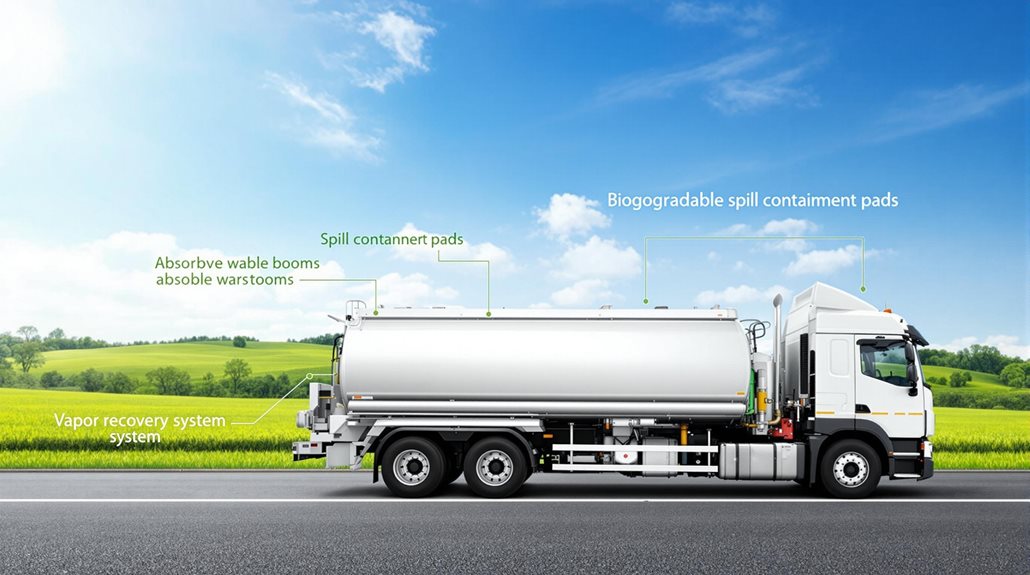
Environmental protection during fuel delivery requires an extensive system of safeguards and protocols that align with local, national, and international regulations. Delivery vehicles are equipped with leak-proof containers, sophisticated monitoring systems, and secondary containment mechanisms designed to prevent spills and environmental contamination. Each vehicle undergoes regular maintenance and is fitted with vapor control nozzles and automatic-closing systems.
Our trained personnel implement thorough safety measures, including the use of spill kits and oil-absorbent materials for immediate response to potential incidents. Storage facilities maintain strict compliance with EPA and OSHA standards, featuring double-walled tanks, advanced leak detection systems, and containment areas capable of holding 110 percent of tank capacity. These integrated safeguards protect water resources and minimize ecological impact throughout the fuel delivery process.
Proof of Delivery Documentation
Beyond environmental safeguards, accurate documentation forms the backbone of every fuel delivery operation. When your fuel arrives, our delivery professionals meticulously record essential details through electronic proof of delivery systems, ensuring transparency and accountability. Each transaction is documented with precise timestamps, quantities delivered, and recipient verification.
| Documentation Element | Purpose | Verification Method |
|---|---|---|
| Delivery Receipt | Transaction Record | Electronic Signature |
| Time Stamp | Delivery Confirmation | GPS-Verified Data |
| Volume Documentation | Quantity Verification | Digital Meter Reading |
| Safety Checklist | Compliance Verification | Electronic Form |
| Customer Authorization | Delivery Approval | Digital Confirmation |
This detailed documentation system safeguards both customer and supplier interests while maintaining regulatory compliance. Your delivery records remain securely stored and accessible through our digital platform, providing instant access for accounting, auditing, or dispute resolution purposes.
Roadside Assistance FAQ
Can I Request a Specific Type of Fuel Delivery Truck Size?
Yes, you can request specific fuel truck sizes to match your needs. Delivery companies offer various options from smaller 1,000-gallon bobtails to larger 8,000-gallon transport trucks.
What Happens if My Tank Gauge Is Broken or Inaccurate?
Our delivery team can use alternative measurement methods like dipsticks or electronic devices to accurately determine your fuel levels. We'll work with you to guarantee precise readings and safe delivery.
Do I Need to Clean the Area Around My Tank Beforehand?
Yes, keeping the area around your tank clean and accessible is essential. Clear away debris, remove obstacles, and guarantee safe pathways for delivery personnel to reach the tank easily.
Will the Delivery Driver Help Troubleshoot Tank Equipment Issues?
While fuel delivery drivers are trained in safety protocols, they typically don't diagnose equipment problems. For technical issues, it's best to contact a qualified fuel system technician.
How Long Does the Fuel Need to Settle Before Using It?
The standard guideline is one hour of settling time per foot of delivered fuel. This allows sediment and moisture to properly settle, ensuring ideal fuel quality and equipment protection.
